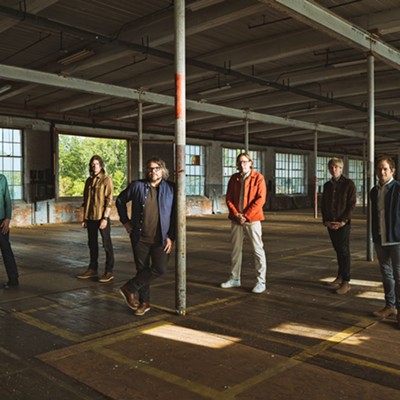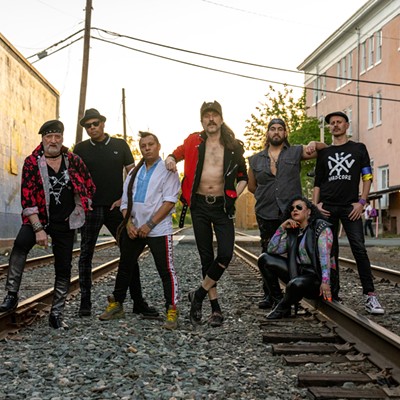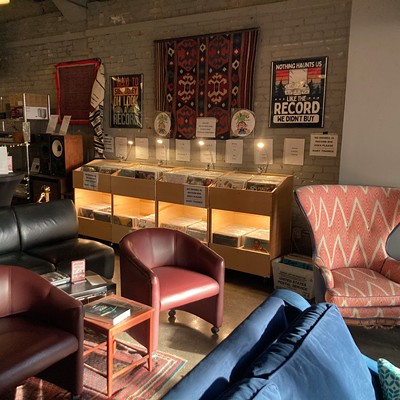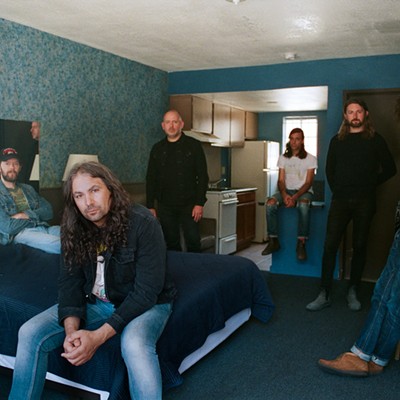Whenever the stage lights go up and the band walks on stage, all glory goes to the musicians when the show goes off without a hitch. But when things go haywire, all eyes are directed to the man or woman behind the mixer.
TOMMY THOMPSON
NEWT TAYLOR
SEAN SUNDSTROM
GEORGE RYAN
Oklahoma Gazette found four local sound engineers who run boards at metro venues as diverse as the notoriously finicky Hi-Lo Club, the acoustically polished Civic Center Music Hall and even high-security prison yards.
TOMMY THOMPSON
As a freelance sound engineer, Tommy Thompson has found himself in enough hairy situations to warrant a "Spinal Tap" sequel. There have been tour manager freak-outs at the Viper Room in Los Angeles, overloaded stage productions, non-English speaking roadies and a Cheap Trick show that was doomed from the second the band showed up at the venue.
"They came in set up for an arena tour and when they got here, they found out it was the Bricktown Brewery," Thompson said. "They had problems from 9 to 2 in the morning. It started with them not being able to use all their gear. Me and the tour engineer went round and round and round, and then their tour manager and I went round and round. We finally got to the point where we said, 'We're going to make this show happen,' and we did."
Thompson's boss even bailed on the show after arriving with more equipment.
"He dropped the stuff and left, saying, 'I don't want no part of this,'" Thompson said, with a laugh. "It was funny 'cause he was dressed and ready to work, but when I turned around,
he was long gone and wouldn't answer his phone."
Luckily, those kind of nightmare scenarios are few and far between, Thompson said, and the majority of a sound engineer's job is dealing with something even more temperamental and eccentric than an overcaffeinated tour manager or the acoustics of a venue.
NEWT TAYLOR
"You have to be able to adapt to different rooms night after night," said Newt Taylor, owner of Oklahoma City's QVR Productions. "When you tour, you are in a new environment every night, so you are stretching your abilities to make the sound work in that new environment. Everything is a factor " the shape and size of the room, how many people will come to the show, if it's hot or cold outside, humidity. Everything goes into how the sound will behave."
After years of touring, Taylor started QVR as a way to settle in Oklahoma with his family; the initials are from the first names of his three children. He now runs sound for churches, recently helped the OKC Farmers Public Market upgrade its building with heavy drapes to cut down on an ongoing echo problem, and he regularly works sound for Lighthouse Prison Ministries.
"The hardest thing that I do now, which is also the most rewarding, is Lighthouse Ministries," Taylor said. "We go into prison yards all over the state with sound and stage packages to put on Christian-based events. The hardest part is going through all the security, all the legwork it takes to just get into each facility. There is a lot of paperwork involved, a lot of security checks, and all of my people have to go through schooling."
As difficult as it is to get in the prison yards, running sound outdoors is comparatively easy, Taylor said, since he just has to turn the volume up and doesn't worry as much about where or how the sound will bounce. Outdoor events don't have as many factors as do smaller, odd-shaped rooms with unpredictable gear.
SEAN SUNDSTROM
Sean Sundstrom said that small rooms are the best places to learn to work with sound since they are the hardest venues to master. He runs the board for shows at the Hi-Lo Club, VZD's, and the Blue Note Lounge, and is preparing for a nationwide tour later this fall.
"Every room is like a person: They are all very different," Sundstrom said. "At the Hi-Lo, you have to get people past two large pillars on the stage. You also have to go to the front of the stage to listen to the music, memorize everything, then run to the back where the soundboard is to fix it. VZD's is a marble room, so you deal with sound waves bouncing off everything, and the Blue Note is similar to VZD's, but with different equipment."
Some clubs won't mind when bands turn it up to 11, but Sundstrom said that Blue Note owner Josh Martin wants the volume controlled so that bartenders don't have to suffer with drink orders screamed at them all night.
Because Sundstrom works at clubs rather than for just one band, he also has to know how to mix different types of music.
"Knowing the band and the music itself is important," he said. "I mess with everything from soul to country to rock 'n' roll to punk. I am really good with roots music. I can do psychedelic because of my own band. They are all so different that it's almost like understanding a different language for each type of music."
GEORGE RYAN
On a very different end of the sound spectrum is George Ryan of Ryan Audio Services. He works sound for the Oklahoma City Philharmonic and the Lyric Theatre at the Civic Center Music Hall. For Ryan, his job is all about "sound reinforcement."
"Sound reinforcement for the Philharmonic and the Lyric is trying just to enhance the sound of the orchestra, not overdrive it," he said. "I'm not trying to get the energy of a rock show, but just trying to get just enough energy into the room to make the most of the Civic Center, which is a beautiful hall acoustically."
Ryan has worked as a sound engineer for 35 years and has served on air and behind the scenes for WKY-AM and KFOR-TV NewsChannel 4. Although orchestras are not exactly simple to dial in, he said that anything with spoken parts is more difficult in the Civic Center.
"I am running upwards of 40 wireless mics at any given time, plus a full orchestra in the pit, plus sound effects playback," he said. "I will typically run 88 inputs at any given time at the Lyric. You are just as much playing traffic cop as being an audio engineer, but a lot of that is making sure that every piece is working and when you put it together, nothing overwhelms you."
He often has a script on hand, color-coded to match the controls so he knows when to adjust the mics of actors as they enter and leave the stage. Microphone mix-ups can result in backstage sound coming out over the speakers, which he said has happened in the past.
"Fortunately, that is rare," Ryan said. "The actors know that anything they say can and will be used against them, so they are good about not talking when they are backstage, especially when they are about to come back onstage."
The Civic Center was designed for orchestral music, so Ryan said that sometimes the acoustics are problematic for singers or speaking parts, especially for older audience members who find it hard to understand the actors. While the seniors might blame Ryan or the actors for their inability to decipher lines, the sounds are actually garbled by the building itself.
Amusingly, he shares the same problem Sundstrom has at the Blue Note: the same eternal rift between sound engineers and rock 'n' rollers who want to rattle windows and split eardrums. So how does Ryan keep the volume down without upsetting the band?
"When you make guitar, bass and drums loud enough, the room really starts to resonate and becomes more unintelligible than you want it to be," he said. "So keeping the guest artist's volume down and explaining to them that it is for their benefit as opposed to rock shows where they can go as loud as they want is often a challenge." "Charles Martin









